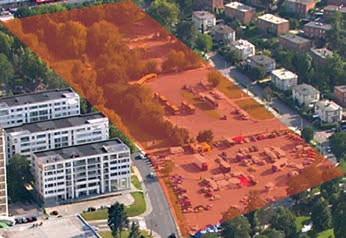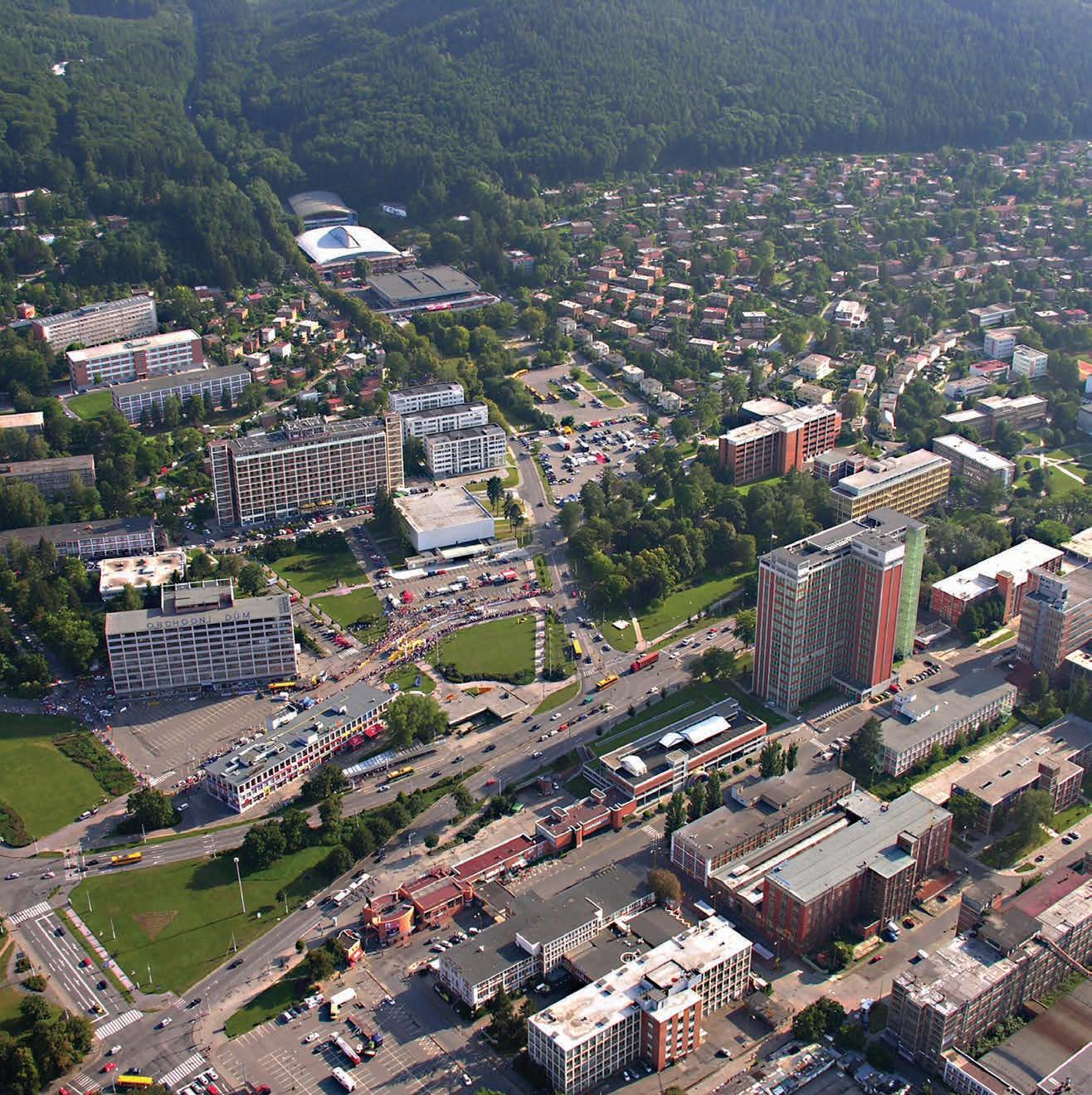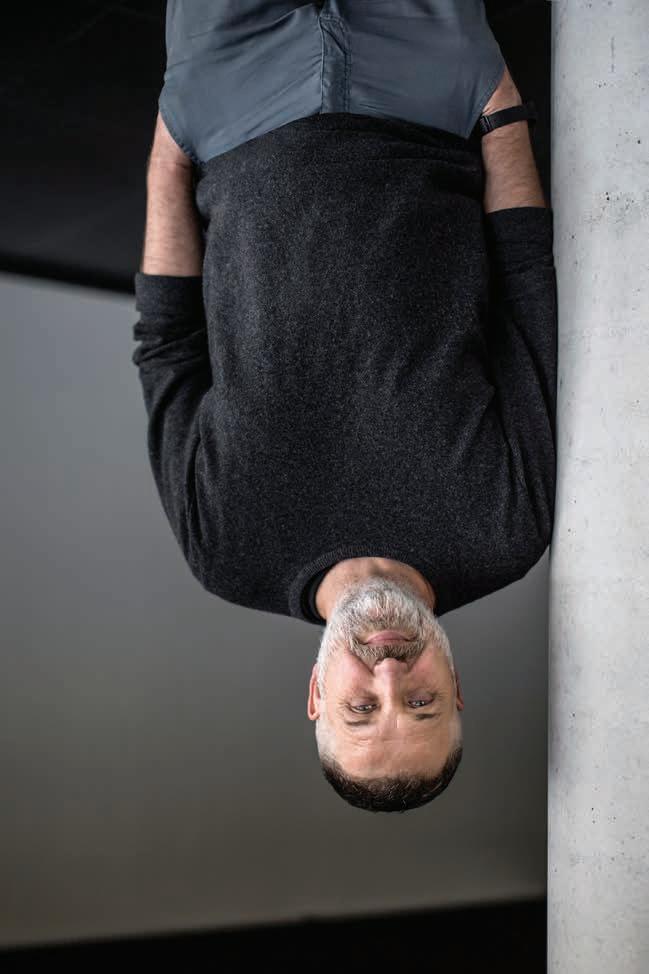
19 minute read
Architekt jako ohrožený druh? Architect as an endangered species?
Architekt, urbanista, milovník historie, hudby a umění, rodák z Kutné. Hory. To je šéf architektonického ateliéru Studio acht Václav Hlaváček..
Byl naším hostem v cyklu redakčních rozhovorů, tentokrát na téma: Urbanismus v menších městech versus velké územní celky v metropoli.
Advertisement
Jak hodnotíte uplynulý rok? Loni nejen u nás v ateliéru, ale myslím i obecně, kulminovaly práce na širších urbanistických celcích, v oblastech se smíšenou nebo bytovou výstavbou. Jediným lékem na –nebudu říkat bytovou krizi, ale předražené bydlení obecně – je fakt, že se byty budou stavět. Ale na územích, která jsou patřičně regulována objemově i z hlediska infrastruktury, dopravy atd. Takže je důležitější neztratit hlavu než stavět paskvily jenom proto, aby se snížila cena. Jde o to, skutečně udržet očekávaný urbanistický vývoj dané oblasti v určitém rámci.
Co myslíte slovem „očekávaný“? Mám na mysli plnění a úpravy územních plánů, ať ve vztahu k Praze a k metropolitnímu plánu, anebo k odstraňování dneska už zřejmých vad územních plánů na úrovni krajských či okresních měst. Územní plán se vyvíjí, musí reagovat na skutečné potřeby dané oblasti. Dokončovali jsme velké urbanistické rozvojové studie a zároveň jsme se snažili v menším měřítku, na úrovni okresních a malých měst, opravit některé zřejmé chyby, které z jejich územních plánů trčely a bránily harmoničtějšímu rozvoji příslušné oblasti.
Můžete zmínit konkrétní příklad? Teď již mohu říci, že se povedla jedna z největších rozvojových studií, a to v Praze na Jižním Městě, v oblasti Opatova a Chodova. Je to území, které bylo dlouho poznamenáno lokálním rozvojem v několika oblastech najednou. Troufám si tvrdit, že tato studie měla velkou ambici na takřka 1 mil. m 2 vlastně sjednotit a zharmonizovat rozvoj městské části i proto, že vlastně zahrnuje obě strany dálnice D1.
Rozumím správně, že se v minulosti na tomto území začalo stavět, ale v určité fázi stavba zamrzla a obyvatelé vlastně žijí v nedokončeném projektu? Přesně tak. Městská část s jistou mírou politických změn na radnici musela čelit parciálním zájmům jednotlivých developerů. Někteří chtěli administrativu, jiní bytový dům, další zase garáže atd. Vůbec se nedivím, že v tomto chaosu jednotlivých malých investic na tak obrovském území, které pracuje se zcela jiným měřítkem, musela být i ta politická reprezentace úplně zmatená. Nehledě na to, že – co se týká „velkého urbanismu“ – nebyla 90. léta a přelom tisíciletí skutečně nijak vyspělou dobou.
Čím se tedy současná koncepce liší? Bez kontaktu s městskou částí, kdy architekt pracuje jen s teoretickými podklady a částí zainteresovaných odborníků, třeba s dopravcem nebo s člověkem, který počítá akustiku, nebo dokonce „jenom“ s krajinným architektem, nepřijde na některé sociální souvislosti – a nejspíš ani na nějakou prostorovou kompozici. Kdyby tato studie nepřekročila D1, tak k dominanci bude vždy lákat zakončení centrálního parku v ose západ – východ u stanice metra Opatov. Zadání prošlo různými školami architektury a pokaždé to bylo stejně… A protože bylo zadání rozšířeno o území na druhé straně dálnice, tak najednou zjišťujete, že tolik diskutovaná výšková úroveň zástavby má šanci navázat na výškové úrovně, které jsou v docházkové vzdálenosti, tedy do 1 km od stanice metra. Což znamená, že na té stanici můžete udělat to, co se očekává, velmi přirozeně. Tedy žádnou megalomanii, žádné mrakodrapy, ale v podstatě naplnit vše, co se v daném místě předpokládá.
ZY Bytové domy v Rožnově pod Radhoštěm Residential houses, Rožnov pod Radhoštěm
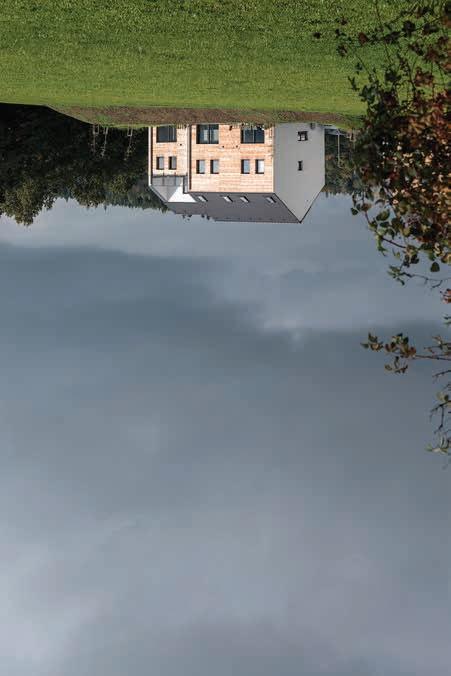
A co lze od takového zadání očekávat? Třeba komerční náměstí – v „lidském“ měřítku. To znamená šesti- až osmipodlažní domy, prostě běžné pro takový prostor. Až teprve v docházkové vzdálenosti můžete hladinu zvedat – ne obráceně. Chápete? Tady se 30 let myslelo, že je to opačně. Tam by měla být dominanta a mělo by to klesat. Ale kam klesat, do starého Chodova? Naopak. Vždyť vlastně většinová zástavba Jižního Města je kolem 12 podlaží a výše. Takže třeba studie objemové kompozice, která nyní obsáhla větší území, může uvažovat v širších souvislostech. To je jedna věc. Nicméně v této oblasti pokaždé narazíme na to, na co se komunisté vůbec neohlíželi, což je konfrontace dvou struktur: vesnické či maloměstské a sídlištní. Ale tam už není potřeba pojmenovávat formy, jestli je to modernistická struktura atd. Prostě je potřeba si říci: Tady je sever, tady je západ, odtud fouká vítr – a pak pracovat v objemech.
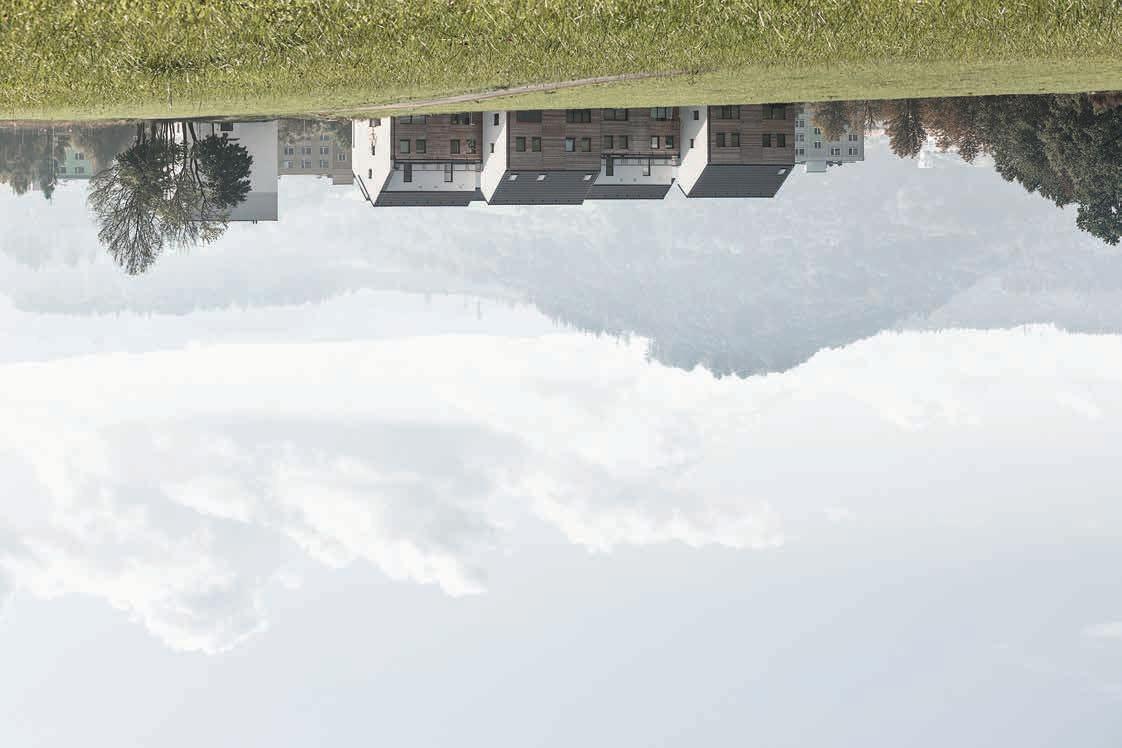
Ono s těmi sídlišti je to asi složitější… Je zajímavé, že některá pražská sídliště, třeba Bohnice, Ďáblice nebo Jihozápadní Město, se pomalu ale jistě se stávají multigeneračními, kdy babička či děda hlídají vnoučata. Není to jen český fenomén, ani nějaká ostuda, v Nizozemsku je situace podobná; je to normální, není to nic staromódního, naopak tohle rodinu více stmeluje. Člověk někde vyroste, objevuje svět, dá si tam první cigáro, první pusu holce a nemá důvod místo, kde vyrostl, opouštět… Dispozice bytů ve starých panelových domech jsou skvělé, mnohdy tisíckrát lepší než produkce 90. let. To víme. Ale jsou monofunkční ve smyslu typovosti. Máme 99 % bytů 3 +1 o iks metrech čtverečních. Ale když chce druhá generace samostatně žít, chce o pár metrů více. Což znamená, že velcí developeři, kteří to s rozvojem bytové zástavby a městských částí myslí vážně, musejí nabídnout – a nabízejí – širší vějíř možností bytových typů. Příslušníci další generace zůstávají a zatím bydlí třeba dva bloky od místa, kde s rodiči vyrůstali, a předávají to svým dětem. Je to přece totéž, jako by někdo byl ze Žižkova nebo ze Smíchova a měl k nim vztah. No, a někdo je z Jižáku… Je to přece cool místo obklopené lesy a parkovým prostředím.
Při představování některých vznikajících projektů místním obyvatelům vzniká téměř nepřátelské prostředí. Leckdy to nebývají smysluplná setkání a často se zvrhnou ve vzájemné hrubé osočování. Ale na druhé straně stojí často nějaký politický vliv jednotlivců, kteří dokážou většinový zájem strhnout k populistickým tématům, což je osvědčené. A zároveň je tu obecná nechuť k něčemu novému – a to není jen u nás. My jsme naši studii zástavby Jižního Města měli možnost veřejně představit zatím třikrát – a budeme pokračovat. Tak složitý organismus, jako je rozvojová studie na dalších 50–100 let, se nedá vysvětlit laikům
za jedno odpoledne, navíc v nervózním prostředí. Nepodceňujme názory lidí, protože když neslyší druhou stranu a budou pod tlakem nějakého politického demagoga z opozice, tak podlehnou názorům typu: Tady bydlím léta, nikdo mě nebude poučovat, stejně jsou za tím jen zisky developerů… Nás ta studie moc bavila, i když to bylo opravdu komplikované. Záběr ve velkém měřítku nám strašně pomohl.
V jakém směru? V porovnání s rozvojem menších měst, jako je Rožnov pod Radhoštěm, Stříbro, Kutná Hora, Milovice atd. Srovnání mě přivedlo k tomu, že právě tam se stávají velké chyby. Obce musely mít v určitém termínu územní plán, takže se urbanismus zvrhl většinou v takovou teoretickou náplň, aby územní plán zahrnoval všechno, co vyžaduje vyhláška. Ale pak najednou zjistíte, že podhorské město by podle územního plánu dovolilo jít do hor výškové zástavbě typu sídlišť z 80. let. A teď změňte územní plán, když máte za sebou investora, který má chuť zaplnit nedostatek bytů ve městě, kde vlastně neexistuje trh. Protože lidé nakonec zjistí, že je lepší si koupit polorozpadlý baráček za kopcem a za cenu nového bytu si ho opravit – a mít k tomu i zahrádku.
To svádí k závěru, že velké území přináší velké starosti a malé město znamená menší starosti. Ale určitě to není tak snadné… Hlavně výsledek je dost podobný a z estetického hlediska vypovídá o kultuře národa. Nesmíte udělat chybu v měřítku a nesmíte slevit z nároku na estetiku, a už vůbec ne na úrovni okresního města. Před rokem jsem byl naplněn entuziasmem, že v okresních městech se všechno jednoduše a rychleji projedná atd. Jenže nakonec se ukáže, když jsme ve fázi územního řízení, že tam neexistuje trh a cena nemůže být vysoká. Tudíž vás začnou opouštět investoři, prodají to, nebo zadají stavebním firmám, aby si to za svou marži postavili. Stavební firma pak prohlásí, že nepotřebuje architekta, že má projektanta. A už to jede: zateplovák, pistáciová barva… A nemohu tam stát s cedulí a říkat: Urbanismus je docela dobrej, to jsme dělali my, ale pak už na nás neměli peníze… Ale nejde o velké peníze, to jsou normální peníze projektanta. Pohybuji se v branži přes 30 let a vím, že to nejsou předražené projekty, protože baráky jsou standardizované, musí se pracovat s konstrukcí. Mrzí nás, když nám tu práci vezmou na úrovni územních řízení, protože mají představu, že architekt je na projektu to nejdražší. Ale to už město nemůže ovlivnit.
Takový trend je vidět třeba v Německu v malých městech, kde je rukopis velmi podobný… Přesně tak. Nám z těch 10–15 zakázek zbyly nakonec dvě. Nevím, jak tohle půjde dál. Tlak na kvalitní architekturu sílí ve velkých městech. Některé jednotlivosti se povedly; nejsem ten, kdo říká, že všechno je špatně. Ne každý chce mít velký ateliér, dělá individuální výstavbu – a dělá ji poctivě a pěkně. Ale to jsou opravdu jednotlivé věci. A když věci chcete změnit, tak ekonomika musí jít společně s vámi. Ale také určitá úroveň kultury.
vou oblastí na úrovni územního rozhodnutí v Praze a měl podřadnou architekturu. Developeři by se mu smáli a nevěřím, že by takovou produkci někdo úspěšně prodával. Takový hlad po bytech zase není a jsou tak drahé, že si rozmyslíte, co si koupíte. Stejně jako je vyspělé publikum ve velkých divadlech, měli by být lidé nároční i na větší výstavbu při naplňování územních plánů. Neplatí to jen pro bytovou výstavbu, ale třeba i pro dopravní řešení. V Holandsku je nemyslitelné, že by dopravní stavbu nekoordinoval architekt. To tady nefunguje…
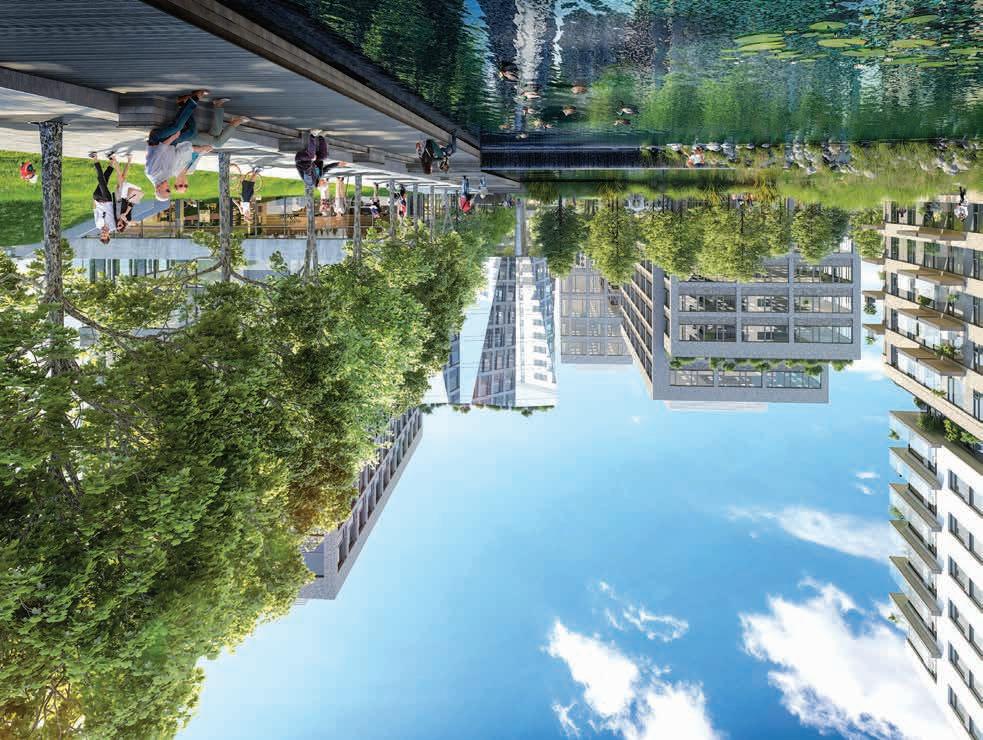

Nový Opatov, Praha, vizualizace Nový Opatov, Prague, visualization
Z kterého projektu na menším městě máte osobně radost? Mám velmi krásný příklad: Rožnov pod Radhoštěm a neuvěřitelně příjemná a korektní spolupráce s vedením města i se stavebním úřadem. Musím potvrdit férové postupy, přísnost stavebního úřadu, který vás skutečně donutí respektovat normy atd. Nyní se staví druhá etapa a ukazuje se, že ta třetí už bude úplně jiný level, jak v použitých materiálech, tak v ceně, která se může malinko zvýšit.
ARNOŠT WAGNER / FOTO: TOMÁŠ SLAVÍK A STUDIO ACHT
An architect, urban planner, history, music and art. lover, a native from Kutná Hora. That is the head of. the architectural studio Studio acht Václav Hlaváček..
He was our guest on the cycle of editorial interviews, this time being the topic of: urbanism in smaller towns versus large territorial areas in the metropolis.
How do you assess last year? The work culminating last year in our studio as well as in general was work on larger urban complexes in areas with mixed or residential development. The only cure for –


Rožnov pod Radhoštěm I won’t say residential crisis but overpriced housing in general – is the fact that apartments will continue being built. But this will be in areas that are appropriately regulated from the point of view of volume as well as infrastructure, transportation etc. So, most important is not to lose one’s cool other than to build a ‘dud’ just for the reason of price reduction. The thing is to sustain anticipated urban development in a particular area within a particular framework.
What do you mean by ‘anticipated’? I mean the fulfilling and modification of outline plans whether it is in relation to Prague or the metropolitan plan or to the disposal of nowadays already evident defects in outline plans on a regional or district level. Outline plan developments must respond to real demand in particular areas. We were completing large urban development studies and also tried, on a smaller level of regional and smaller towns, to correct some evident errors that stood out from them and prevented more harmonious development in a particular area.

Can you give us a particular example? Already now I can say that we were successful with one of the largest development studies, this being for Jižní město in Prague, the areas of Opatov and Chodov. It is an area that was, for long, affected by local development in several areas. I dare say that this study had great ambitions for almost 1 million sq m to actually unify and harmonize the development of the city district for there are both sides of the D1 motorway.
Do I understand it correctly that building activities were commenced in this area in the past, but the development froze in a particular phase and residents actually live in an incomplete project? That’s exactly right. The city district had to a certain extent re political changes at the council, face partial interest from individual developers. Some wanted administration, others a housing block and others wanted garages, etc. I am not at all surprised that even political representation was completely confused by all this chaos in the small individual investments in such a large area that works on an entirely different level. Regardless of the fact that – regarding ‘bid urbanism’ – the 1990s and the turn of the millennium were not that an advanced period.
How then does the current concept differ? Without contact with the city district, when the architect works only with theoretical data and part of involved specialists, for instance a haulier or a person that calculates acoustics, or even ‘just’ with a landscape architect, there is some social coherence and probably even some special composition that doesn’t get tackled. If this study didn’t cross the D1, dominance would be enticed by the completion of the central part situated in the west axis – the exit by the Opatov underground station. The assignment went through various architectural schools and the result was always the same… And as the assignment was expanded by the area on the other side of the motorway, you suddenly find out that the so discussed height of the development has an opportunity to follow up the level of development situated within walking distance, that is up to 1 km from the underground station. That means that you can do what is anticipated at that station naturally. No megalomania, no skyscrapers, but basically to fulfil what is anticipated.
And what can be anticipated from such an assignment? For instance, a commercial square – on a ‘human’ level. That means six to eight-storey buildings, that is normal buildings for such an area. It is only in that walking distance that you can start raising the level – not the other way around. Do you understand that? For 30 years, it was believed to be the other way around. There should be the dominant point and should descend. But where to? To the old area of Chodov? On the contrary, for the majority of Jižní Město development it is about 12 storeys and more. So, in the study of column composition, which now covers a larger area, one can consider the broader context. That’s one thing. Nevertheless, we always come across what the communists didn’t take into consideration in this area, that is the confrontation of the two structures: rural and provincial as well as a housing development. But there it is not necessary anymore to name the form, whether it is a modernist structure or others. One must simply say: there is the north, there is the west, this is where the wind blows from – and then to work in volumes.
The situation with housing development is probably more complicated… What is interesting is that some housing developments in Prague, for instance Bohnice, Ďáblice or Jihozápadní Město, are slowly but surely turning into multigeneration areas where grandparents look after grandchildren. It is not just a Czech phenomenon nor some embarrassment. The situation in the Netherlands is similar; it is normal; nothing oldfashioned. On the contrary, it brings the family together more. One grows up somewhere, explores the world, has a first cigarette there, kisses his first girlfriend and has no reason to leave the place he grew up in, to leave… The layouts in the old panel houses are great, often a thousand times better than the 1990s production. We know that. But they are monofunctional with regards to their type. We have 99%
of apartments with a layout of two bedrooms and X sq m. But when the other generation wants to live independently, they want a few more square metres. That means that the large developers who are serious about residential housing development and development of urban districts, they must offer – and they do offer – a broader range of housing type possibilities. Members of the next generation stay and live perhaps some two blocks away from the place they grew up in with their parents and pass it onto their children. It is the same as if someone was from Žižkov or Smíchov and had some relationship to it. And someone is from Jižní Město… It is, after all, a cool place surrounded by woods and parks.
Introducing some of the emerging projects to local citizens created an unfriendly environment. Sometimes these meetings are not useful and often turn into mutual accusations. But on the other side, there is often some individuals’ political influence, whereby then can sweep the majority interest to populist topics, which is well-proven, and there is also a general reluctance to anything new – and that does not only apply to our country. We have so far had a chance to publicize our study for the development of Jižní Město three times – and we will continue doing so. Such a difficult organism like a development study for the next 50–100 years cannot be explained to laics in one afternoon and also on top of that in an uneasy environment. We don’t underestimate people’s opinions because if they don’t hear the other side and are under pressure from some political demagogue, they tend to succumb to opinions like: I have lived here for years; nobody will preach to me, it is only about developers’ profits… We really enjoyed doing the study even though it was really complicated. The large scope really helped us.
In which way? Compared with small town development such as Rožnov pod Radhoštěm, Stříbro, Kutná Hora, Milovice, etc. The comparison showed me that it is there where big mistakes are made. Municipalities had to have the outline plan within a particular period so urbanism got out of hand and turned albeit usually into theoretical tasks in order for the outline plan to include everything that is required by regulations. But then you suddenly find out that a submontane town would, according to an outline plan, allow for a development of the 1980s housing development type in the mountains. And then you try to change the outline plan when there is an investor who is willing to fulfil the lack of apartments in town and where there is actually no market. Because people eventually find out that it is better to buy a half derelict house behind a hill and reconstruct it for the price of a new apartment – and also to have a garden with it.
This tempts one to come to the conclusion that large areas come with big worries and small town with small worries. But it is certainly not that easy… It is mainly the result that is quite similar and from an aesthetic point of view, this shows the culture of the nation. You mustn’t make a mistake in the scope and you mustn’t reduce your aesthetic demands, definitely not when work
ing on the level of a district town. A year ago, I was full of enthusiasm that everything gets discussed and negotiated simply and quickly in district towns… But when we get to the phase of planning procedures, we see that there is no market and that price can be high. Which means that investors start leaving you or they sell it or assign building companies to build it for their margins. The building company then declares that they don’t need an architect as they have a planning engineer. And then it goes: thermal insulation, pistachio colour… And I cannot stand there with a banner and say: Urbanism is quite good, that’s what we did, but then they didn’t have any more money for us… Though it is not about big money. It is normal planning engineer’s pay. I have been in this field for more than 30 years and I know that projects are not overpriced as the buildings are standardized and the structure is really worked with. We are obviously unhappy when they take work away from us in the phase of planning procedures because they feel that an architect is the most expensive part of the project. But that is something the town cannot affect anymore.
Such trends can be, for instance, seen in small towns in Germany, where the appearance is very similar… Exactly. We were eventually left with two out of the 10–15 procurements. I don’t know how it is to proceed. Pressure being put on quality architecture is strengthening in large towns. Some details worked out well; I am not one to say that everything is wrong. Not everyone wants a large studio, attending to individual development – and does it honestly and nicely. But those are just details. And when you want to change them, the economy must be with you. As well as some sort of level of culture.
Is it given by project quality? I cannot imagine anyone today to come along with a development area in Prague in a phase of outline planning and with secondary architecture. Developers would laugh at him and I don’t believe that someone would be able to sell such a production successfully. There is no such hunger for apartments and they are so expensive that you will think twice before you buy something. Just as you have an advanced audience in large theatres, people should also be demanding when fulfilling outline plans in the case of larger development. This does not only apply to housing development but also for road construction solutions. It is unthinkable in Holland for road constructions not to be coordinated by an architect. That does not work here…
What project in a smaller town pleases you personally? I have one very nice example: Rožnov pod Radhoštěm and an incredibly pleasant and correct co-operation with the town council and building office. I must confirm fair and square processes, strictness of the building office, which really makes you respect the norms, etc. The second stage is currently under construction and it shows that the third one will already be on an entirely different level, both with regards to utilized materials as well as the price that may increase a little.
ARNOŠT WAGNER / PHOTO: TOMÁŠ SLAVÍK AND STUDIO ACHT
